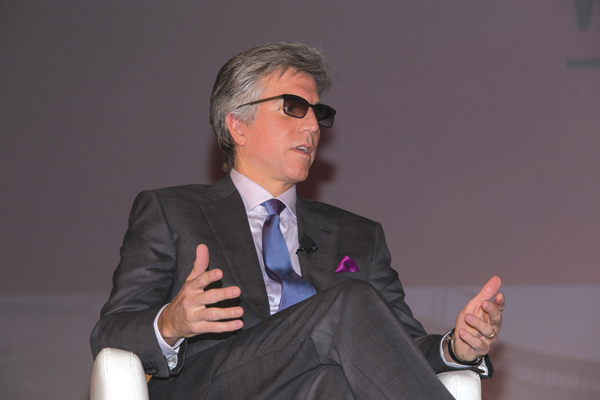
 |
Photo by: TONY FLOREZ PHOTOGRAPHY
|
Sometimes all you got
is the dream.
The difference between the people that make mistakes and lose and the … people that make mistakes and win is resilience, grit, determination, raw commitment.
It’s a mistake to slip, fall, and nearly cut yourself to death but, guess what, it’s the best thing that ever happened because as I look back on it all now, I got the wisdom of someone who’s 85, and that’s a lot older than I am.
And I still have the raw determination of the 21-year-old kid that went for that interview that day in New York City and got his dream job knocking on cold doors.
I was a [Xerox] trainee working for a senior guy getting mentored how to sell. And you know what that meant? That meant I was the mule. I got to carry the copier on my back, the electronic typewriter in my right hand and the brochure-filled briefcase in my left hand.
The hustle and the ability to read the room is probably the most important skill that I think you get by working hard because if you deal with enough people and enough situations, you have a reflex instinct about what to do.
You don’t need PowerPoints, you don’t need slides, because you’re so human, you’re so real, you’re so in the moment, life takes over.
What I learned about leadership right off the bat was that I didn’t know everything about management, but what I did know is that I could hire people that were a lot smarter than me and a lot better than me.
And I told them: I’ll choose to do what I do well often, and I won’t do what I don’t do so well at all. You’ll do that.
We started to hone in on individual skills and what people were good at.
Some could sell, some could write proposals, some could do math, some could talk, and then we created a mini team where we developed leaders of people that wanted to rise and that could help other people.
The big idea was having the goal that we’re to be the best, No. 1.
You have to create a culture where the expectation is extreme accountability, extreme professionalism, and you purport yourself as a professional in everything you do, everything you say, and when you make a mistake you own it and take it like a professional.
The highest form of respect is the truth. And when you look somebody in the eye and you tell them the truth and they’re not willing to give it up for that highest level of excellence then they will resign.
I think the best way to reach millennials is [to] stop trying to reach millennials.
This whole idea of let me have the smoothie waiting for you as you get off the elevator and let’s wear Velcro suits and stick to walls and bring your dog and play foosball and let’s hang out on the couch and pretend like we’re young together — they see through it so quickly.

What I have done with millennial people is basically given them really big jobs.
Attract them by showing evidence that you get it and you’re willing to take chances and you realize you have to keep the companies young and vibrant and experimental and it’s OK to fail.
The biggest problems that are out there, whether it’s health care or it’s digitizing companies, are going to be solved through digitization, and this generation just instinctively grew up with it. It’s in their DNA, it’s in their veins, and without them we’re not going to get there.
In the new world, not everybody is going to touch every flagpole on the way to the finish line. There are going to be people that are uniquely gifted to take shortcuts.
Even though you work harder and you’ve been there longer, I’m asking you to learn new tricks so you can take shortcuts and get us to the final goalpost so we win as well.
[Under Armour] went public in 2005. I became a board member then and they were a pre-IPO company, probably a couple hundred million U.S. dollars, and they basically sold great performance shirts and pants and shorts and stuff.
But the big idea is how do I take that garment, which is nanotechnology enabled, connected to the device … [and] connect it to communities, because all these athletes participate in communities that they really feel good about.
If you look at the NBA, millions of statistics and fan engagements on their site per month based upon SAP HANA and the individual fan experience connecting with their athletes, connecting with the statistics, connecting with the history of the game, it’s totally awesome.
Now the NHL is working on a very sophisticated technology in the puck where you would essentially have a sensor in the puck that would give you a unique experience as a fan in being able to track the digital puck and really look how that ties into movements and statistics and biorhythms.
The NFL, you think about draft day, now we have real time in-memory technology connected with all the options teams could make as they select an athlete.






